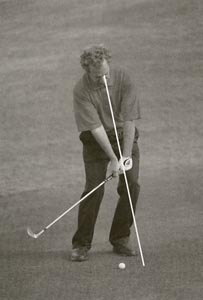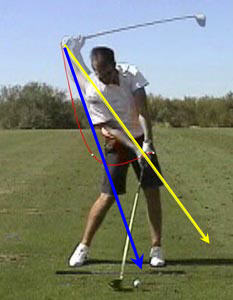6-E-2. THE AIMING POINT CONCEPT The hands and the clubhead combine as Clubhead Lag (5-0, 6-C) and can be utilized to execute 'Delivery.' And the shorter Clubs take less time to reach the In-Line condition from a given Release Point than do the Longer Clubs, due to the Law of Conservation of Angular Momentum (6-C-2-B).In essence, the hands and clubhead combine for clubhead lag and 'deliver' themselves to the ball. Shorter clubs take less time for the golfer to 'release the club' than longer clubs. This is because longer clubs swing on a wider arc which takes more time for the golfer to 'release the club.'
And the difference in travel distance per degree of Angular Motion because Impact always occurs during the 'Pulley' portion of the Endless Belt travel (sketch 2-K #6) regardless of the direction of its straight line travel between pulleys (or of the Thrust during the Circle Path per 7-23) because both of those lines represent the True Delivery Paths and move - physically - directly at the point on the Ball through which the Angle of Approach passes even with Aiming Point procedures; because the Machine delivers the #3 Pressure Point to Impact Fix Hand Location AT IMPACT with all Delivery Paths, Delivery Lies, Pulley Sizes, etc. becaue its structure is designed to do just that; hence the importance of a sturdy structure around the Endless Belt machinery.Okay, a lot of mumbo jumbo here that I really don't quite understand. But Homer Kelley seems to be explaining why and how the aiming point concept works.
That is what makes the Aiming Point Procedure possible at all. The Aiming Point replaces the ball so you no longer direct the #3 Pressure Point at the Ball, but at the Aiming Point just as if it were the Ball - Like an explosion shot from the sand.The #3 Pressure Point is the first joint or the lowest joint in the right index finger (if you're a righty). So what I interpret Mr. Kelley to say is that in a bunker you hit down on the sand at the ball. Mr. Kelley wants you to do the same thing, but at the 'Aiming Point' with the #3 Pressure Point.
Here's one way to look at it. At the top of the swing the right arm folds, it then steadily extends on the downswing. At impact it will still be bent and then after impact it will extend completely (or 'thrust').
Here's a pic of Tiger at impact. Notice how the right arm is still slightly bent.
 Now here's Tiger just after impact. His right arm is fully extended. Or his right arm has 'thrusted.'
Now here's Tiger just after impact. His right arm is fully extended. Or his right arm has 'thrusted.'
The 'Aiming Point Concept' wants Tiger to 'thrust' his hands at a specific point in front of the ball on the downswing. Just get to the top of the swing, focus at the point where you want the hands at impact, take aim and thrust those hands at the Aiming Point. You can do this if your a Hitter or a Swinger or both.
Experiment with until you grasp the effects of Ball Positioning (2-N), directing the Lag Pressure Loading (6-C-2-A) at-and through per 4-0 - an Aiming Point can be pin-pointed by experiment and experience only, be 'normal' Handspeed differs among players. Increased Handspeed and/or a Sweep Release moves it aft of its normal Handspeed location and decreased Handspeed and/or Trigger Delay moves it forward. 10-24 presents additional detail.
Mr. Kelley is saying that a golfer needs to experiment with the Aiming Point to find what works best for them because things like ball positioning and lag effect where the Aiming Point will be. Furthermore, if you have fast hands or a Sweep Release (http://3jack.blogspot.com/2009/03/full-sweep-release-and-circular.html) moves the aiming point backward away from the target. Decreased handspeed or trigger delay (like Sergio as he has the wrists fully cocked just as he's about to hit the ball) means the golfer should move the aiming point forward.
So again.
Longer Clubs = move the aiming point backward
Shorter Clubs = move the aiming point forward
I skipped over a few sentences, but I pick it up at one point
Actually, when in doubt, there is always the Impact Fix Hand Location procedure (7-8)
Basically if you're still struggling you can move your hands to the 'Impact Fix procedure.' Just take your normal address position and now move your hands at address like you would have then at impact with the hands in front of the ball and clubhead and with some shaft lean. Then you can look at where your hands are at 'Impact Fix' and take your swing and use where your hands were at 'Impact Fix' as your aiming point.
If you 'choke down' on longer Clubs you move their Aiming Point forward. 'Choke Down' to make all clubshafts the same lengths means the same Aiming Point for all your Clubs - shorter radius but precise timing. Everything is a 'Trade Off.'Pretty straight forward. Choke up on a longer club, your aiming point moves forward. If you choke up on your clubs so they are the same length as your pitching wedge, then your aiming point will be the same for each club.
Remember - Aiming Point concerns only:
1. Clubshaft Length
2. Handspeed
3. Release Point - regardless of Ball Location
Here's a pic of Bobby Clampett using the Aiming Point in his book 'The Impact Zone.'

And here's a brilliant picture made by Jeff Mann over at http://perfectgolfswingreview.net/

The red line is the actual path of Baddeley's hands. The yellow line represents the 'aiming point' for shorter irons. The blue line represents the 'aiming point' for a driver, which is still slightly ahead of the ball.
3JACK
4 comments:
Richie,
I also read Clampetts book, and have been trying to incorporate in my swing also. One thing I am curious about -- if you are aiming in front of the ball, shouldn't you be looking there also? In other words, if I look at the ball, how do I aim in front. I have been trying to hit without looking at the ball, and looking at the aiming point, with mixed results.
I also feel like I am releasing early if I try to do the "thrust" after impact.
I just discovered your site, very nice!
[url=http://vioperdosas.net/][img]http://vioperdosas.net/img-add/euro2.jpg[/img][/url]
[b]dreamweaver software for sale, [url=http://sapresodas.net/]where to buy software to[/url]
[url=http://vioperdosas.net/]e commerce store software[/url] cheapest computer software kaspersky internet security 2009 keys
acdsee 10 photo manager [url=http://sapresodas.net/]autocad pdf converter lines overwrite[/url] discount software students
[url=http://vioperdosas.net/]free nero 7[/url] software for academics
[url=http://sapresodas.net/]buy photoshop brush[/url] buy software cd
nero 9 freeware download [url=http://sapresodas.net/]softwares to buy[/url][/b]
Technology truly is an inescapable aspect of our daily lives, and I am fairly confident when I say that we have passed the point of no return in our relationship with technology.
I don't mean this in a bad way, of course! Societal concerns aside... I just hope that as technology further innovates, the possibility of transferring our memories onto a digital medium becomes a true reality. It's one of the things I really wish I could see in my lifetime.
(Posted on Nintendo DS running [url=http://knol.google.com/k/anonymous/-/9v7ff0hnkzef/1]R4[/url] DS KwZa)
Your quotes from TGM here aren't in my version. My book copyright is 1982 and I bought it directly from Ben Doyle in the late 80's/early 90's. Which version is this from?
Post a Comment